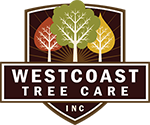With a harsh winter now behind us, many of us are ready to get outside and start enjoying the warm, spring weather. Spring, however, comes with its own patterns of extreme weather. Thunderstorms combined with high winds can have a big impact on our outdoor landscapes. While the wind can easily pass through dormant trees during the winter, the situation can change dramatically with the added weight of new growth.
High winds combined with heavy rain can twist, push or bend weak areas of a tree causing it to fail. That’s why pruning and preventative tree care is so important. Trees require pruning to promote new growth, prevent overgrowth, removed damaged and diseased branches while improving the aesthetics of your landscape. Pruning will also help your trees withstand high wind storms thus reducing the risk of tree damage when severe weather strikes.
In an effort to prevent a hazardous situation from occurring, the certified arborist at Westcoast Tree Care would like to provide you with the following list of warning signs that may indicate a tree is susceptible to spring storm damage.
Tree Damage Warning Signs
Root Rot – When a tree has an unstable foundation due to rotting roots, it has the potential to uproot and fall over. Signs to look out for include mushrooms at the base, cavities or insect damage.
Leaning – Leaning or lopsided trees naturally present more of a hazard than those that grow vertically. Leaning trees should be a cause for alarm and immediate action. While it’s not uncommon for a tree to grow off center, any sudden lean may indicate breakage or a weakening of supporting roots.
Poor Branch Structure – When two branches of equal or lesser size originate from the same union, they are often weaker and more prone to splitting. In this situation, a certified arborist may choose to cut one branch back or remove it altogether to prevent a hazardous situation from happening.
Clustered Canopy – Trees with thick, internal branches and leaves tend to create a larger windsail effect, causing potential breakage during high wind storms. Additionally, branches that rub together also tend to weaken over time and are good candidates for failure.
Deadwood – By removing deadwood from a tree, a certified arborist is able to improve the health of the tree while increasing its beauty. Removing deadwood also protects against disease, insect infestation, long-term decay, heavy winds and fire hazard.
Excessive Branch Weight – Heavy, horizontal limbs tend to fight gravity and heavy wind loads. This increases the chances of breakage or tree failure. A certified arborist will prune these type of branches to an acceptable, lateral length or cut them back to the main trunk as necessary to prevent a hazardous situation from happening.
Cankers – Spots on a tree where the cambium and bark are dead are called cankers. As a tree grows the area around the canker will not grow with it. Cankers can weaken a tree and cause it to fail as less wood is available to support the weight of a growing tree.
Contact Westcoast Tree Care
When it comes to the safety of you and your loved ones, it’s important to monitor the health and safety of the trees before a spring storm hits.
At Mountain West Arbor Care, we work hard to make sure the trees on your property are healthy, well-maintained and as safe as possible. We can evaluate your trees and help minimize any potential safety hazards by keeping them pruned and cared for. If you suspect any of the warning signs listed above, it’s important to have your tree inspected by a tree care professional. Our certified arborist would be more than happy answer any questions you may have and look over your property while providing you with a no-cost, no-obligation quote. Contact us at 1.800.767.8733 (TREE).








